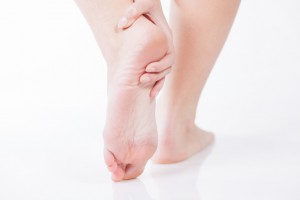The Most Common Causes Of Heel Pain
 Heel pain can be serious or mild but if left untreated can always lead to bigger problems. Knowing the most common causes of heel pain will help you identify the source of your discomfort and produce a reliable treatment plan to decrease pain and allow your heels to heal.
Heel pain can be serious or mild but if left untreated can always lead to bigger problems. Knowing the most common causes of heel pain will help you identify the source of your discomfort and produce a reliable treatment plan to decrease pain and allow your heels to heal.
Your feet absorb a great deal of pressure every single day as they get you all around town. Every step you take is big thanks to your feet, so if you start to experience foot pain, more specifically heel pain, it can be rather worrisome and even debilitating. The key is to find the cause of the pain as soon as possible to prevent worsening of the problem.
Some of the most common causes of heel pain include:
- Achilles tendinitis
- Achilles tendon rupture
- Heel spur
- Gout
- Bursitis
- Fibromyalgia
- Osteomyelitis
- Peripheral neuropathy
- Rheumatoid arthritis
- Stress fractures
- Tendinitis
- Planter fasciitis
- Pinched nerve
This list does not represent all causes of heel pain and you will want to speak with a doctor to confirm any diagnosis and create an appropriate treatment plan.
Here is a closer look at 5 of the most common causes of heel pain from the above list:
1. Achilles Tendinitis
Achilles tendinitis occurs when the Achilles tendon is overused, often during a sport like running. The strong tissues that connect your heel bone to your calf muscles are made up of rubber-like bands. The pain starts off mild at the back of the leg or above the heel, and generally strikes just after going for a run or partaking in some other activity.
Treatment is mild and is mostly self-care, but if no action is taken recurring episodes could turn into a more serious tendon tear or rupture that requires surgery to repair.
See a doctor if you are noticing constant pain around your Achilles tendon. If the pain becomes severe enough to interfere with daily life you may have a ruptured tendon, in which case you need immediate medical attention. (Reference)
2. Achilles Tendon Rupture
The Achilles tendon is a strong cord connecting your back calf muscles to your heel bone. When this fibrous cord becomes overstretched it can tear all the way or partially.
A ruptured Achilles tendon usually comes with a popping sound, and then a sharp pain in the back of your ankle or lower leg. This sudden injury may impact your ability to walk. There are both surgical and non-surgical options available for treatment depending on the severity of your rupture. (Reference)
Visit a doctor immediately after you hear a popping sound associated with an Achilles tendon rupture, especially if you are struggling to walk.
3. Planter Fasciitis
Planter fasciitis is among the most popular causes of heel pain. This causes a stabbing pain due to a swollen plantar fascia, the thick band of tissues that connect your heel and toes along the length of your foot.
Planter fasciitis commonly produces the most pain within the first few steps of the day. Usually with mild movement the pain eases up, although long periods of standing or being in the same position may reignite discomfort.
If you are a runner, overweight, or wear unsupportive shoes you are more likely to develop planter fasciitis.
If you suspect you have planter fasciitis you should visit a doctor as soon possible. Without proper treatment this disorder may cause chronic heel pain that eventually interferes with your daily life. Also, it is common for people to alter their walk in order to reduce pain associated with planter fasciitis, but as a result you will end up with foot, knee, hip or back problems. (Reference)
4. Bursitis
Bursitis is a painful condition that can affect any part of your body where there is a fluid-filled sac known as bursae. A bursae sac acts as a cushion for the tendons, bones and muscles surrounding your joints. Bursas can be found in your shoulder, elbow, hip, knee, toes and heel. When bursae is inflamed it is known as bursitis. Repetitive movements are often the cause, and treatment includes rest of the affected area. Flare-ups are common.
See a doctor for bursitis if:
- You have debilitating joint pain.
- Pain lasting for over one week.
- Lots of swelling, bruising, redness or a rash.
- Sharp pain that persists when you exercise or use your feet.
- A fever
5. Stress Fractures
If you develop tiny cracks in your bone it is known as a stress fracture. Overuse of your feet, such as running long distances or jumping, can cause stress fractures to form. If you have osteoporosis you are at a greater risk for stress fractures even without overexertion.
Stress fractures are most commonly diagnosed in the lower leg and foot, or rather the weight-bearing bones. Athletes are always at risk, as well as people starting off a new workout regime too fast too soon. The pain generally starts off mild and then worsens over time at which point you may notice some swelling. Pain associated with stress fractures usually decrease with rest.
See a doctor if your pain is severe or persistent even after resting. (Reference)
For heel pain answers and relief visit your local Urgent Medical Center today. From our family to yours, we are here for you!
